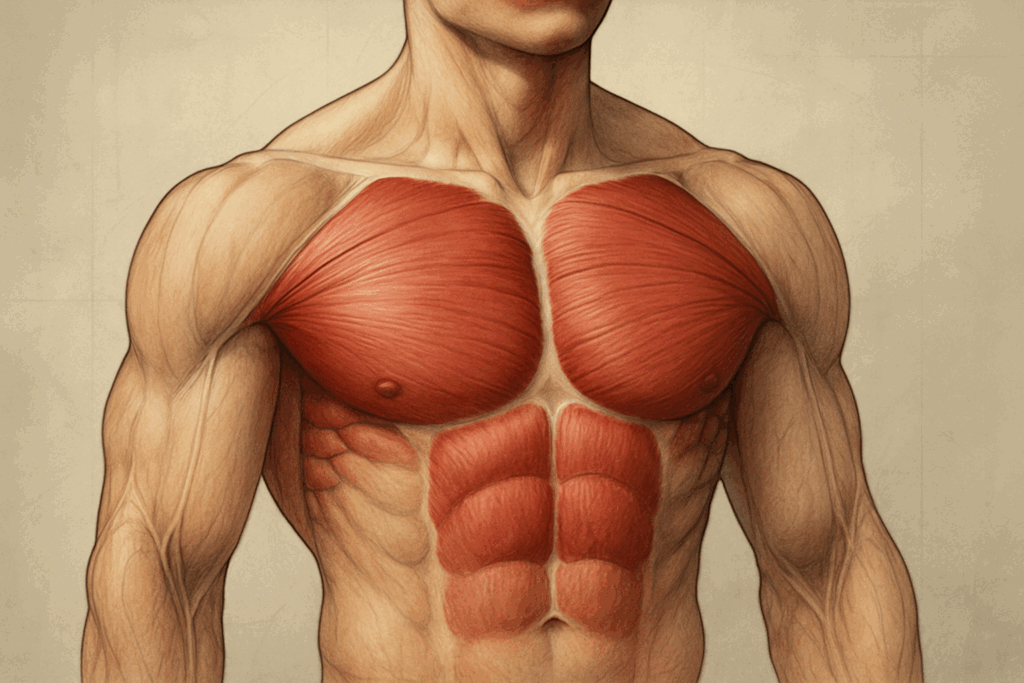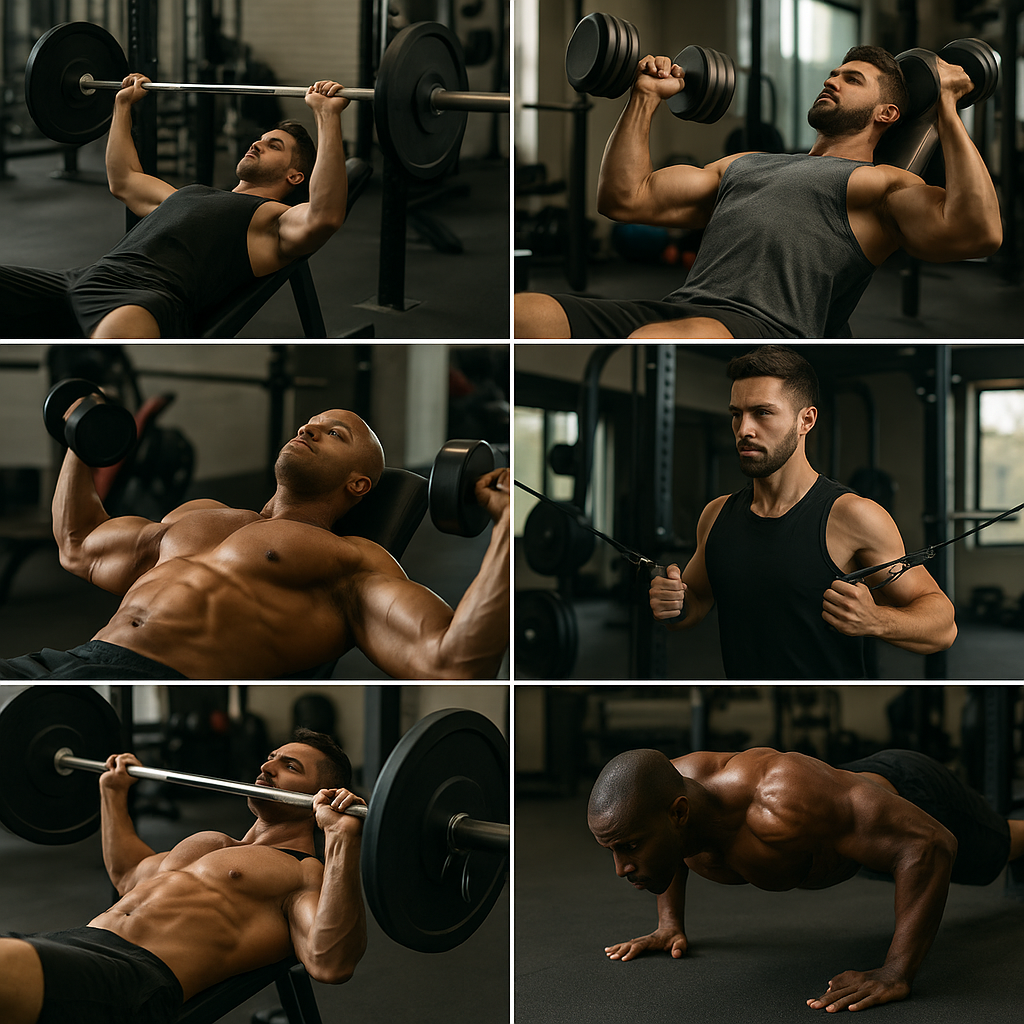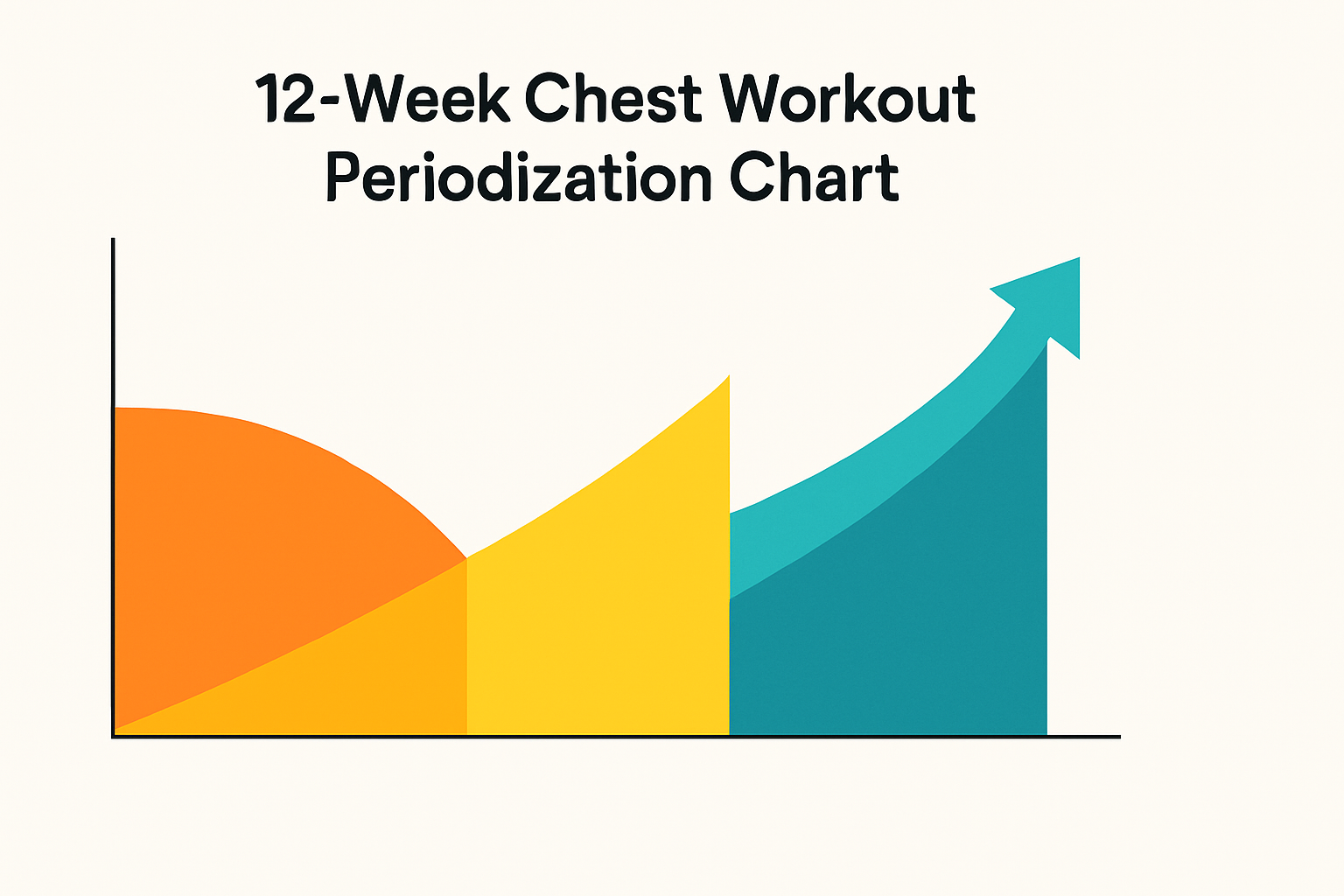Introduction
A well-sculpted chest is often viewed as a hallmark of physical fitness, masculine strength, and dedicated training. But achieving a balanced, muscular, and powerful chest isn’t just about aesthetics—it’s also essential for functional strength, posture, and upper body coordination. The ultimate chest workout plan for men not only emphasizes hypertrophy and strength but also focuses on definition, symmetry, and long-term muscular health. In this comprehensive guide, we will explore advanced principles of training, exercise selection, progressive overload, recovery protocols, and the science of chest development in the context of both anatomy and physiology. Designed for a college graduate-level audience, this article aims to elevate your understanding and execution of chest training for lasting gains.
You may also like: The Ultimate 30-Day Workout Plan for Men Working Out in the Gym: Proven Full Body Strength Exercises to Maximize Results
Understanding Chest Anatomy: The Foundation of Effective Training
Before diving into any chest workout program for men, it is essential to understand the muscle groups involved in chest training. The chest primarily comprises two key muscles: the pectoralis major and the pectoralis minor. The pectoralis major is the more visible, fan-shaped muscle that spans from the sternum and clavicle to the humerus. It consists of three distinct regions: the clavicular (upper), sternal (middle), and costal (lower) heads. Each of these regions responds differently to various angles of movement, making exercise variety crucial for full development.
The pectoralis minor lies beneath the pectoralis major and functions to stabilize the scapula. Although not as prominent, this smaller muscle plays an important role in shoulder health and movement. Supporting muscles, such as the anterior deltoids and triceps brachii, also engage during chest exercises, particularly pressing movements. Understanding this interconnected musculature is vital for creating a chest workout plan for men that targets the pecs effectively while minimizing the risk of injury.

Scientific Principles of Muscle Growth and Hypertrophy
At the core of any strength training strategy lies the principle of hypertrophy—the process of muscle fibers increasing in size due to mechanical tension, metabolic stress, and muscle damage. Effective chest training must incorporate these stimuli to foster adaptation. Mechanical tension is primarily achieved through heavy compound lifts like the bench press, which load the muscles with resistance over a full range of motion. Metabolic stress results from higher rep ranges, shorter rest periods, and techniques like drop sets or supersets that create an intense “burn” through lactate accumulation.
Muscle damage, while less desirable in excess, contributes to growth by triggering inflammatory responses and subsequent repair mechanisms. However, it must be carefully managed to prevent overtraining. Volume (sets x reps x load), frequency (number of sessions per week), and intensity (percentage of 1RM) are the key variables manipulated to create progressive overload. Without systematic progression, the body will adapt and gains will stagnate.
Crafting the Ultimate Chest Workout Plan for Men
Creating a chest workout plan for men requires a sophisticated balance of compound and isolation exercises, strategic programming, and intelligent periodization. Compound movements such as barbell bench presses, dumbbell presses, and incline presses should form the foundation of the program, as they engage multiple joints and muscles, allowing for greater loading and overall hypertrophy. Incline variations specifically target the upper chest, which is often underdeveloped in many lifters.
Isolation exercises, including cable crossovers, pec flyes, and machine presses, serve to fine-tune specific regions of the pectorals and enhance muscle definition. By varying angles, grip widths, and tempo, you can influence the activation of different pectoral fibers. For instance, slower eccentric phases have been shown to increase muscle activation and hypertrophic response. Integrating isometric holds and partial range movements can further intensify the stimulus, especially at the end of a workout when fatigue is high.

Structuring Your Weekly Training Schedule
An effective chest workout program for men is not simply about training harder; it’s about training smarter. Recovery, muscle protein synthesis, and central nervous system fatigue all influence training frequency and volume. For most individuals, training chest twice per week allows for optimal stimulus without excessive fatigue. A split routine might pair chest with triceps or shoulders, depending on recovery capacity and overall volume management.
A sample weekly schedule could include a heavy pressing day focused on compound lifts with lower reps (4-6 reps per set) and a secondary hypertrophy day emphasizing moderate loads and higher reps (8-15 reps). Rest intervals should vary accordingly, with longer rest (2-3 minutes) for strength-focused sets and shorter rest (30-90 seconds) for hypertrophy-driven sessions. Rotating between incline, flat, and decline variations ensures comprehensive chest development and avoids adaptive plateaus.
Essential Exercises in a Chest Workout Program for Men
- Barbell Bench Press – The gold standard for chest strength, this exercise allows for maximum load and progressive overload. Utilizing a moderate to wide grip emphasizes pectoral recruitment.
- Incline Dumbbell Press – This movement targets the upper chest and provides a greater range of motion than the barbell version, allowing for unilateral balance and control.
- Flat Dumbbell Flyes – Ideal for stretching and isolating the pecs, flyes emphasize the eccentric phase and help improve muscle length and definition.
- Cable Crossovers – These allow for constant tension throughout the movement, particularly effective in the mid-to-late stages of a workout for hypertrophic stress.
- Decline Bench Press – Useful for emphasizing the lower portion of the pectorals, this variation also reduces strain on the shoulders, making it joint-friendly.
- Push-Up Variations – Incline, decline, and weighted push-ups offer functional strength gains and can be used effectively in high-rep finishers or bodyweight routines.

Periodization and Long-Term Programming Strategies
No chest workout plan for men would be complete without a discussion on periodization—the strategic variation of training variables over time to avoid plateaus and optimize long-term progress. Periodization typically involves macrocycles (months), mesocycles (weeks), and microcycles (days). A linear periodization model increases load and intensity gradually, while an undulating model varies volume and intensity more frequently.
A 12-week program might begin with a hypertrophy-focused phase (3-4 weeks), followed by a strength phase (3-4 weeks), and concluding with a peaking or power phase. During hypertrophy blocks, emphasize higher volume, moderate intensity, and isolation work. Strength phases should prioritize compound lifts at higher intensities (80-90% 1RM) with lower volume. Deload weeks every 4-6 weeks allow recovery and promote long-term sustainability.

Optimizing Nutrition and Recovery for Chest Development
Training provides the stimulus, but nutrition and recovery facilitate adaptation. Protein intake is paramount for muscle repair and hypertrophy. Aim for 1.6 to 2.2 grams of protein per kilogram of body weight daily, spread across 3-5 meals. Carbohydrates play a crucial role in glycogen replenishment and training performance, particularly around workouts.
Post-workout nutrition should include a blend of fast-digesting protein and carbohydrates to stimulate muscle protein synthesis. Adequate sleep (7-9 hours per night) and stress management further support recovery. Supplementation can be helpful but should not replace whole foods. Creatine monohydrate, beta-alanine, and caffeine are evidence-based ergogenic aids that may enhance strength and training performance when used appropriately.

Common Mistakes in Chest Training and How to Avoid Them
Many lifters fall into the trap of focusing solely on the flat bench press, neglecting upper and lower chest development. This creates muscular imbalances and aesthetic disproportions. Overreliance on machines or poor form can also limit activation and increase injury risk. Shoulder and elbow positioning must be optimized to minimize joint strain and maximize pec engagement.
Neglecting recovery, failing to warm up properly, and not utilizing full range of motion are other frequent errors. Avoid bouncing the bar off the chest or using excessive momentum, which reduces muscular tension and increases injury risk. Incorporating warm-up sets, mobility drills, and pre-activation exercises can improve neuromuscular recruitment and reduce injury potential.
Progress Tracking and Measurement for Lasting Results
Objective progress tracking is essential for motivation and program refinement. While mirror gains and subjective strength perception are helpful, measurable metrics offer more reliable feedback. Track weights, reps, sets, and perceived exertion (RPE) using a training log or digital app. Monthly strength tests or rep max evaluations can guide progression and help assess program efficacy.
Photographic comparisons, circumference measurements, and skinfold calipers provide additional insight into muscular growth and body composition changes. Biofeedback indicators like sleep quality, energy levels, and joint health also inform training adjustments. A truly effective chest workout program for men is one that evolves over time in response to individual adaptation.
Functional Benefits of Chest Training Beyond Aesthetics
While the primary motivation for chest training is often visual, functional benefits should not be overlooked. A strong chest improves upper body pushing strength, essential for sports like football, wrestling, swimming, and martial arts. It also supports shoulder joint integrity, reducing the risk of injury in overhead movements.
Postural correction is another key benefit. Many individuals develop a hunched posture due to prolonged sitting and anterior chain dominance. Strengthening the chest, when balanced with upper back training, contributes to improved alignment and muscular synergy. Daily movements such as pushing open a door or lifting objects become more efficient and injury-resistant with a well-developed chest.
Advanced Techniques to Intensify Your Chest Workouts
Once foundational strength is established, advanced techniques can be employed to further stimulate growth. Techniques such as rest-pause sets, drop sets, and supersets introduce novel stimuli and increase training density. Rest-pause sets involve taking short intra-set rests to perform additional reps beyond initial fatigue. This method allows you to surpass traditional failure points and increase time under tension.
Tempo manipulation, such as performing a 3-second eccentric and 1-second concentric, can also enhance neuromuscular control and metabolic stress. Incorporating resistance bands or chains adds accommodating resistance, where load increases through the range of motion, matching strength curves. Partial reps and isometric pauses at peak contraction points further challenge the muscle and stimulate underutilized fibers.

Frequently Asked Questions About Chest Training and Advanced Muscle Development
1. What are the long-term benefits of following a structured chest workout plan for men beyond muscle growth?
A structured chest workout plan for men provides significant long-term advantages beyond just aesthetic improvements. Over time, consistent chest training enhances posture, particularly countering the forward-rounded shoulder position caused by desk-bound lifestyles. It also contributes to shoulder joint stability and upper body coordination, reducing the likelihood of chronic pain or mobility limitations as one ages. Additionally, well-developed pectoral strength plays a critical role in functional tasks such as pushing, throwing, and lifting, thereby improving performance in both athletic and everyday activities. From a psychological standpoint, achieving progressive strength gains fosters confidence, self-discipline, and a strong mind-muscle connection that benefits other areas of fitness and life.
2. How does psychological consistency impact the success of a chest workout program for men?
Consistency in training is often influenced more by psychological factors than by physical limitations. Motivation, habit formation, and goal-setting are all essential components of a successful chest workout program for men. For example, those who tie their training to intrinsic motivations—such as improving posture, relieving stress, or boosting energy—are more likely to stick with their plan long-term. In contrast, those who train purely for aesthetics may lose interest if results plateau. Developing routines, using visualization techniques, or even training with a partner can reinforce psychological commitment and make the training experience more rewarding and sustainable.
3. Is it effective to train the chest with calisthenics alone, or is weightlifting essential?
Calisthenics-based training can be highly effective for chest development, especially for beginners and those focused on functional strength. Exercises like push-ups, dips, and their advanced variations—such as archer push-ups and ring push-ups—engage the chest intensely and can be adapted for progressive overload using resistance bands, weighted vests, or mechanical advantage techniques. While weightlifting allows for greater load and precision in targeting specific chest regions, calisthenics offer unique benefits in terms of core engagement, joint control, and proprioception. For those seeking hypertrophy, incorporating resistance training into a chest workout plan for men may accelerate muscle growth, but bodyweight routines can certainly serve as a foundation or effective complement.
4. What role does mobility play in enhancing a chest workout program for men?
Mobility is an often-overlooked component that directly affects the efficiency and safety of chest training. Poor thoracic spine mobility or tightness in the shoulders can restrict range of motion during pressing movements, leading to compensatory mechanics that strain joints and under-activate target muscles. Incorporating mobility drills such as thoracic extensions, shoulder dislocates, and scapular control exercises into a warm-up routine can significantly enhance muscle activation and form. Improved mobility also ensures more even development across the chest and reduces the risk of overuse injuries. In advanced stages of a chest workout program for men, mobility becomes even more critical to unlock new training variations and optimize performance.
5. Can high-frequency chest training be safe and beneficial for experienced lifters?
Yes, high-frequency training—defined as training a muscle group three or more times per week—can be both safe and beneficial for experienced lifters when programmed intelligently. This approach allows for more practice of technique, more total weekly volume, and a more even distribution of fatigue, which can enhance recovery between sessions. However, exercise variation, load management, and recovery strategies must be tightly controlled. For example, alternating between heavy pressing one day and lighter, higher-rep isolation work the next prevents overreaching. High-frequency methods are particularly effective when chest training is a specific focus and other muscle groups are kept at maintenance volume.
6. How should a chest workout plan for men be adjusted as they age?
As men age, the body responds differently to training stress, and a chest workout plan for men should be adapted to accommodate these changes. Joint resilience often decreases, making warm-ups and mobility work more important than ever. Older individuals may benefit from reducing maximal lifting sessions in favor of moderate loads with higher reps and slower tempos to maintain intensity without compromising joint health. Recovery protocols, including sleep, hydration, and active recovery, also take on heightened importance. Emphasizing form, full range of motion, and mind-muscle connection can yield better results than chasing heavy loads, particularly for those over 40. Resistance bands and machines may also serve as joint-friendly alternatives to heavy free weights.
7. What are some emerging trends in chest workout program design?
Recent trends in chest workout programming emphasize personalization, technology integration, and recovery optimization. Wearable devices and smart gym equipment now provide real-time feedback on reps, tempo, and range of motion, allowing lifters to optimize every set. Additionally, blood flow restriction (BFR) training is gaining popularity for stimulating hypertrophy with lighter loads, reducing joint stress while maintaining muscle engagement. There’s also growing interest in cluster sets and velocity-based training, which involve tracking bar speed to regulate intensity. These innovations make it easier to fine-tune a chest workout program for men, helping users push past plateaus without overtraining.
8. How do sleep and circadian rhythms affect chest development?
Sleep quality and circadian rhythm regulation are vital to maximizing gains from any chest workout plan for men. During deep sleep stages, growth hormone is released in significant quantities, aiding in muscle repair and tissue regeneration. Poor sleep disrupts this process and elevates cortisol levels, which can impair recovery and reduce anabolic potential. Training at times aligned with your circadian rhythm—typically late morning to early afternoon for most people—can enhance performance and hormonal response. Consistently sleeping seven to nine hours per night, maintaining a regular sleep-wake schedule, and avoiding blue light exposure before bed are critical habits for supporting optimal chest development.
9. Can overtraining the chest create muscular imbalances or postural issues?
Absolutely. Overemphasis on chest training—particularly with pressing exercises—without corresponding attention to the upper back and posterior deltoids can create postural imbalances and increase injury risk. This phenomenon, often referred to as “pec dominance,” can lead to rounded shoulders, scapular dyskinesis, and even shoulder impingement. A balanced chest workout program for men should incorporate pulling movements such as rows and face pulls to ensure postural integrity. Additionally, training the serratus anterior and rotator cuff muscles is essential for maintaining scapular health and overall shoulder mechanics. Periodic assessment of posture and strength ratios between pushing and pulling movements can help identify and correct imbalances before they become problematic.
10. What are some strategies to maintain motivation during a long-term chest workout plan for men?
Sustaining motivation during a long-term chest workout plan for men requires more than just periodic goal setting. Incorporating novelty into training—through new exercise variations, different rep schemes, or challenges such as AMRAPs (as many reps as possible)—can keep sessions engaging. Tracking progress visually and numerically through photos and performance logs helps reinforce consistency. Training with a partner or coach also provides accountability and can add an element of social motivation. Lastly, revisiting personal “why” statements—whether it’s boosting confidence, improving health, or excelling in a sport—grounds your effort in purpose and reinforces long-term commitment. Engaging emotionally with your training journey often makes the discipline more fulfilling and sustainable.
Conclusion: Building a Stronger, Defined Chest Through Science and Strategy
Crafting and following the ultimate chest workout plan for men is a multidimensional endeavor that goes far beyond bench pressing heavy weights. It involves a scientific understanding of muscular anatomy, a strategic application of training principles, a keen awareness of nutritional needs, and a disciplined approach to recovery. By integrating progressive overload, exercise variety, intelligent programming, and recovery optimization, you not only build a more defined and powerful chest but also enhance functional strength and resilience.
A well-structured chest workout program for men should reflect both short-term goals and long-term progression, incorporating adaptable techniques that respond to the body’s changing needs. When executed with intention, education, and consistency, your chest training becomes more than just a physical challenge—it evolves into a refined discipline that cultivates both strength and mastery over time.





